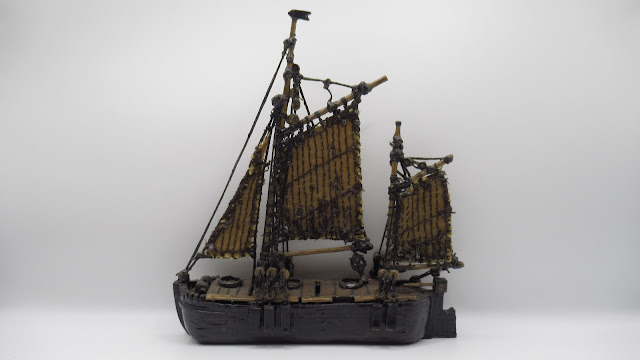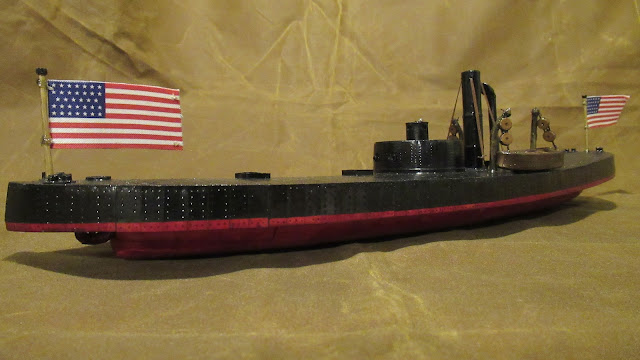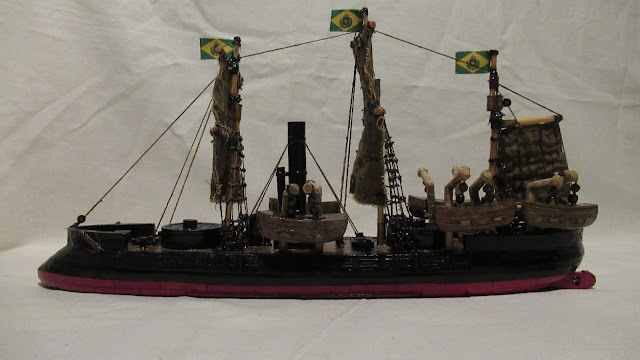Known Trades of Jigger Flats
Ketch-rigged sailing barges, known in Cheshire and Lancashire as jigger flats, were built along the banks of the River Mersey from the late nineteenth century until the early twentieth century. The mizzenmast, shorter than the mainmast, was also known as a jigger mast and this may explain from where these trading barges got their name. These merchant vessels, a variation of the Mersey flat, were owned by businesses such as the Liverpool Lighterage Company and the United Alkali Company. A distinction arose between the mastless cut flats, or dumb barges, that did not leave the inland waterways and the sailing flats which were seagoing vessels. Sailing flats, including the ketch-rigged variety, could be towed along canals and rivers by horses or barge haulers but their rigging allowed them to operate in open waters. Jigger flats were built for coastal trade and made frequent voyages into the Bay of Liverpool, Dee Estuary and Irish Sea while their dimensions allowed them to navigate the inland waterways. North Wales, with its rich reserves of stone and ore, was a common destination for ketch-rigged Mersey flats and many were lost at sea during these perilous journeys.
1) Bricks.
Cheshire has rich deposits of clay, left on a bedrock of Triassic sandstone during the Last Glacial Period, and this mineral resource has been exploited by local people for centuries. The clay, dredged from the bottom of the Irish Sea by massive ice sheets as they moved eastwards, was fashioned into bricks that were used in local building projects or transported elsewhere in Britain. Coal, extracted from pits in Cheshire or Lancashire, fuelled the kilns in which bricks were fired and was often transported via the network of navigable rivers and canals. Florence, a ketch-rigged Mersey flat, ran aground off the Welsh coast while transporting a shipment of bricks from Runcorn to Holyhead and had to be rescued by the lifeboat that was stationed at Beaumaris. Rocks and sandbanks, hidden beneath the water or concealed by darkness as well as fog, posed a hazard to vessels that ventured into these waters. The jigger flat ran aground on the 2nd of February, 1932, and was stranded for two days before the lifeboat was able to rescue its crew. The sailing flat, built at Winsford and launched in 1892, was not recovered and her wreck remains buried in the sand.
2) Coal.
Coal, the principle fuel of the Industrial Revolution, was transported by Mersey flats along the navigable waterways of Cumbria and Lancashire. The Bridgewater Canal and Sankey Canal, for example, were built for the coal trade and designed to accommodate the local barges. Mersey flats carried coal along the inland waterways during the eighteenth, nineteenth and twentieth centuries. Michael Stammers claims, on page 93 of Mersey Flats and Flatmen (1993), that a ketch-rigged barge by the name of Jane transported coal along the River Severn after she was purchased by business interests in Somerset. The trading vessel, launched in 1800, spent fifty-nine years on the Bridgewater Canal and Weaver Navigation before it began its new career in the southern part of Britain. It is possible that Jane was regarded as a Severn trow, the sailing barge of South West England, due to the fact that it was converted to a ketch while in Southern ownership and had possessed a single mast prior to this. It could be argued, however, that Jane qualifies as a jigger flat due to fact that it was built at Runcorn and fitted with an additional mizzenmast during its working life.
3) Granite.
Granite, an igneous rock, appears at sites of former volcanic activity and has long been valued as an excellent building material. Stammers, on page 127 of his book about Mersey flats, explains that granite was shipped in large quantities to the South Docks of Liverpool and that the cargo originated from quarries in Ireland and North Wales. Jigger flats and schooners, Stammers claims, were involved in the transport of granite to Liverpool and the stone arrived as crushed rock or as carved paving slabs. Canning Half Tide Dock, designed by Jesse Hartley and opened in 1844, is named as one of the major unloading points for stone while much of the granite is said to have been sourced from Penmaenmawr. Railway wagons, carrying granite from the Penmaenmawr quarry, descended inclined planes to a tramway which ran to the coast and terminated at a loading jetty. Merchant ships, including ketch-rigged Mersey flats, would be filled with stone from the loading jetty. The maritime granite trade between North Wales and Liverpool, Stammers explains, continued until the 1930s and jigger flats carried much of this stone to the city's unloading docks.
4) Iron ore and steel.
Iron ore was mined at Cleator Moor, Egremont, Furness as well as Millom in Cumbria and was transported along the West Coast of Britain by water. The River Mersey, within comfortable sailing distance of ports in Cheshire and Lancashire, was an obvious destination for ore carriers due to the presence of foundries in the area. Business interests in Mostyn, situated on the Dee Estuary in Flintshire, smelted iron ore and the extracted metal was shipped to Liverpool where it was used in local construction projects. Increased iron production meant that the frames of buildings, such as warehouses and churches, could be built from this ferrous metal while William and John Laird began constructing iron ships at Birkenhead in the 1820s. Stammers, on page 103 of his book about the flat-bottomed barges of North West England, claims that iron ore and steel was transported to Liverpool by steamship where it was unloaded into the holds of jigger flats which were owned by the Liverpool Lighterage Company. The company, incorporated in 1896 and headquartered at 26 Drury Buildings in Water Street, owned both sailing flats and steam-powered vessels.
Iron ore was mined at Cleator Moor, Egremont, Furness as well as Millom in Cumbria and was transported along the West Coast of Britain by water. The River Mersey, within comfortable sailing distance of ports in Cheshire and Lancashire, was an obvious destination for ore carriers due to the presence of foundries in the area. Business interests in Mostyn, situated on the Dee Estuary in Flintshire, smelted iron ore and the extracted metal was shipped to Liverpool where it was used in local construction projects. Increased iron production meant that the frames of buildings, such as warehouses and churches, could be built from this ferrous metal while William and John Laird began constructing iron ships at Birkenhead in the 1820s. Stammers, on page 103 of his book about the flat-bottomed barges of North West England, claims that iron ore and steel was transported to Liverpool by steamship where it was unloaded into the holds of jigger flats which were owned by the Liverpool Lighterage Company. The company, incorporated in 1896 and headquartered at 26 Drury Buildings in Water Street, owned both sailing flats and steam-powered vessels.
5) Limestone.
Limestone, a form of calcium carbonate, is one of four ingredients used in the manufacture of sodium carbonate via the Leblanc process. Sodium carbonate, also known as soda ash, was produced by burning sodium-rich vegetation before Nicolas Leblanc discovered his method of creating the industrial chemical in laboratory conditions. A chemical reaction of coal, limestone, sodium chloride and sulphuric acid produces sodium carbonate which is used in the manufacture of glass, paper, soap and textiles. Washing soda, another name for the chemical, was a common domestic cleaning agent. Stammers, on page 111 of his book about Mersey flats, states that the jigger flats Eustace Carey and Santa Rosa shipped limestone from the Welsh port of Flint to the United Alkali Company's soda works at Fleetwood in Lancashire. United Alkali Company Limited, established in 1890, commissioned the Clare and Ridgeway shipyard at Sankey Bridges to build the sailing barges in 1905 and 1906. The company, merging commercial entities that manufactured soda ash via the Leblanc method, was formed to reverse the fortunes of this failing sector of the chemical industry.
6) Manganese ore.
Manganese ore, mined in North Wales, has a variety of industrial uses and demand for the mineral increased after Robert Hadfield patented his manganese steel alloy in 1883. Hadfield steel, known for its exceptional durability and hardness, was manufactured in Sheffield and a continual source of manganese ore was required to meet the demand for this wear-resistant alloy. Welsh ore, however, was of inferior quality to foreign ore and the British steel industry tended to rely on overseas imports. World War One, however, disrupted the supply of foreign ore and the Welsh mines were opened again to meet the demands of wartime industry. John and William, a ketch-rigged Mersey flat, was carrying manganese ore when it foundered in Mostyn Deep in 1916 and the likelihood is that its ill-fated cargo was intended for the manufacture of steel. It is possible, however, that the jigger flat was destined for the Pilkington glassworks at St. Helens which used manganese ore to impart colour to its products. C.G. Down, on pages 9 and 14 of The Manganese Mines of North Wales that was published in 1980, states that the St. Helens glassworks sourced its ore from Wales.
7) Slate.
North Wales is famous for its slate quarries and this metamorphic rock, formed from shale under high temperatures, was exported via the maritime trade links that existed between the Welsh ports and the rest of Britain. Slate, possessing a natural grain that allows it to be split into sheets, is a high-quality roofing material. Ant, a ketch-rigged sailing flat that was operated by Clare's Lighterage Company, sank in the Dee Estuary while she was transporting from Port Dinorwic to Sankey Bridges. Many of the ships that arrived at Port Dinorwic, known in Welsh as Y Felinheli, would have originated from Cheshire and Lancashire. The jigger flat, launched in 1863 and wrecked during the February of 1907, sank after a collision with SS Jane while anchored at Wild Roads near Mostyn. Westerly winds, blowing at gale force seven, extinguished the flame of the warning light as the sailors slept below deck. John Waterworth and Richard Wainwright, the merchant vessel's two crewmembers, were rescued but the roofing slates were lost along with the ship. Litigation followed, in which the proprietors of Ant sued the owners of SS Jane, but the court decided in favor of the defendant in this case.
8) Timber.
County Wicklow, situated on the East Coast of Ireland, is home to extensive forests and a natural harbour that enables local timber to exported to overseas destinations. Ash, beech, elm, hazel, oak, pine as well as horse and sweet chestnut trees have fed the county's substantial timber reserves while trading vessels from Britain shipped this valuable commodity over the Irish Sea. One such vessel, a sailing flat named Ada Mary that was equipped with an additional jigger mast, was sunk while transporting timber from County Wicklow to Windnes in the March of 1919. The sailing flat, headed for the River Mersey, was damaged in a storm and dropped its twin anchors while drifting towards the shoreline of North Wales. The ship, battered by waves and assailed by gail-force winds, lost its sails and rigging as well as one of its anchor cables before it transmitted a distress signal that was received by the local lifeboat station. Theodore Price, the Llandudno lifeboat, performed a daring rescue mission that saved the lives of the two crewmen. John Owen, the rescue vessel's coxswain, received a bronze medal for his bravery.
Conclusion.
It would seem that jigger flats, the most advanced of the Mersey sailing barges, spent much of their working lives participating in the maritime stone trade between North Wales and Liverpool. Other ports, as far inland as St. Helens, were also recipients of the raw materials that ketch-rigged Mersey flats imported. The finished products of local industry, such as bricks, could also be exported to locations outside of Cheshire and Lancashire. The record of losses out at sea, either from collisions or because of foul weather, suggests that these sailing barges were better suited to working the canals and rivers than braving offshore waters. Jigger flats, when operating on inshore waters, would have had less use for their sails and may have been hauled by horses via the towpaths. These working vessels, alongside their gaff or sloop-rigged cousins, played an important role in keeping the wheels of industry turning during the late-Victorian and Edwardian eras. Many businesses, operating at a time when fuel-burning engines were making sail-power obsolete, thought that the addition of trading ketches to their commercial fleets was a worthwhile investment.
Last updated on the 8th of October, 2023, which was a Saturday.





Comments
Post a Comment